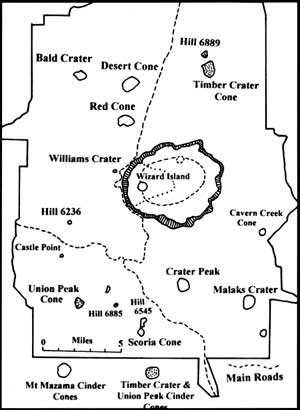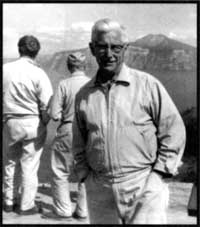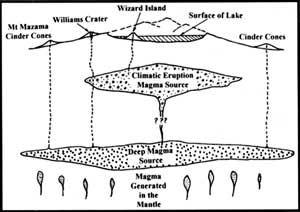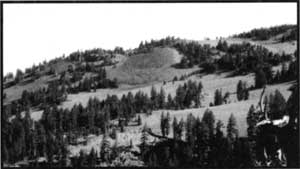Cinder Cones in Crater Lake National Park
By K. R. Cranson
Visitors to this national park marvel at the spectacle of a large volcano that collapsed nearly eight thousand years ago to produce a basin now filled with indescribably blue water. Indeed, the geological story of what happened to produce the Crater Lake basin that we see today may be the best description of a “young” caldera in the world. There are, however, numerous other interesting volcanic features in the park. At least 20 cinder cones have been identified within the boundaries of Crater Lake National Park. And, of course, Wizard Island, the most famous of these, rises more than 700 feet above the lake’s surface near the western shoreline and is well known to all visitors.
Cinder cones as landforms
 One simple method of classifying volcanoes groups them into three categories: shield volcanoes, strato-volcanoes, and cinder cones. Shield volcanoes are massive, low, dome-shaped features produced primarily by fluid lava flows, and usually composed of basalt. The islands of Hawaii are examples of these huge volcanic features but only a small portion is visible above sea level. A strato-volcano is constructed layer by layer of more or less alternating lava flows and pyroclastics (loose fragments erupted during explosive activity) that tend to be large features on land with relatively steep slopes. They are the subjects of picture postcards and calendars. In the Cascade Range, Mount Rainier and Mount Shasta are good examples of strato-volcanoes.Figure 1: Location of the major cinder cones in Crater Lake National Park, Oregon. The dashed line inside the caldera represents the location of Merriam Cone and the ring fracture zone where post caldera eruptions reached the surface. The Central Platform is outlined by the dotted line. Sketch by the author.
One simple method of classifying volcanoes groups them into three categories: shield volcanoes, strato-volcanoes, and cinder cones. Shield volcanoes are massive, low, dome-shaped features produced primarily by fluid lava flows, and usually composed of basalt. The islands of Hawaii are examples of these huge volcanic features but only a small portion is visible above sea level. A strato-volcano is constructed layer by layer of more or less alternating lava flows and pyroclastics (loose fragments erupted during explosive activity) that tend to be large features on land with relatively steep slopes. They are the subjects of picture postcards and calendars. In the Cascade Range, Mount Rainier and Mount Shasta are good examples of strato-volcanoes.Figure 1: Location of the major cinder cones in Crater Lake National Park, Oregon. The dashed line inside the caldera represents the location of Merriam Cone and the ring fracture zone where post caldera eruptions reached the surface. The Central Platform is outlined by the dotted line. Sketch by the author.
Cinder cones are the “baby” members of the volcano family listed above. They seldom exceed a mile across at the base and a thousand feet high. Unlike the shield or strato-volcanoes, this smallest member of the volcano family have an extremely short life span—being active for just days to a few months in most cases. Only in rare occasions does their activity extend for a year or more. From a geological perspective, this is like an instant or a snapshot in the volcanic record of an area. Due to their origins, cinder cones are called “monogenetic,” with the entire feature built during one eruption episode from one source of magma.
A typical cinder cone eruption begins by venting magma rich in gas that expands, producing solid fragmental volcanic products like blocks, bombs, scoria, ash and dust. This ejected material, the pyroclastics noted above, accumulates at a single location to build an inverted cone around the vent. The larger and heavier particles collect closest to the vent, while smaller and lighter ones drift farther—or are carried away by the wind. As the cone grows, a central region may develop composed of the larger pieces (blocks, bombs and scoria) mixed with more fluid magma that hardens into a rigid core. On a young cone this core is seldom seen as it is usually buried by additional pyroclastic material blown out of the vent later.
In time, the gas dissolved in the magma that powered the explosive initial eruption is exhausted and magma reaches the surface as lava. When this happens, lava flows may break out from the base of the cinder cone and flow away from the volcano. Magma forming cinder cones is typically basaltic or basaltic-andesite in composition. Lavas with this composition tend to be relatively hot and flow readily, sometimes for great distances. Although the most prominent part of these small volcanic features is the cone that develops, associated lava flows may actually contain up to ten times more volcanic material. Since cinder cones are relatively small features, they are often overlooked. They are, however, the most abundant kind of volcanic cone—being common worldwide and numbering in the thousands. One report suggests that at least 400 cinder cones have formed in the Oregon portion of the Cascade Range alone. Most of those in Crater Lake National Park are associated with the construction of Mount Mazama. Wizard Island, of course, was formed in the caldera following the collapse of Mazama’s summit.
Cinder cones generally develop in volcanic areas that do not have larger volcanoes, or are associated with more massive volcanic cones. Those related to larger volcanic features, like shield and strato-volcanoes, usually develop along weak areas in existing rock. Such zones are often referred to as basement fractures and tend to be radial to the larger volcano—something like the spokes of a wheel. Although this is not obvious for the cinder cones at Crater Lake, connecting certain pairs does produce a crude radial pattern. Examples are Desert Cone and Red Cone, or Scoria Cone and the adjacent Hill 6545.
Cinder cones in the park
The cinder cones in Crater Lake National Park fit into two categories: those associated with the small basaltic shield cones of Union Peak and Timber Crater, and all the others that are related to Mount Mazama. Hill 6902 and the cinder cone on its summit appear to be part of the Timber Crater shield volcano in the northern portion of the park. In a like manner, the southwestern quadrant holds Castle Point and its summit cones, along with several smaller cinder cones belonging to the Union Peak shield volcano.
Red Cone and Desert Cone, clustered in the Pumice Desert in the northwestern section of the park, are good examples of cones related to Mount Mazama. Both appear symmetrical when viewed from the North Entrance road, a distance of about a mile. As with most other cinder cones throughout the park, both have a symmetrical appearance when viewed from above. Other prominent Mount Mazama cinder cones include Bald Crater, Crater Peak, Scoria Cone and Maklaks Crater—the latter is called Diller Cone on older maps.
 Howell Williams at Crater Lake in 1965. NPS photo by Ed Paine. |
The cinder cones associated with Mount Mazama exhibit a large range in volume. Of the eight more prominent cones for which a volume has been determined, Crater Peak is the largest with a volume of just under a tenth of a cubic kilometer. Hill 6545, near Scoria Cone, is the smallest measuring somewhat less than a tenth the size of Crater Peak. Wizard Island’s volume falls about midway between these extremes.
Unlike the typical cinder cones described above, cinder cones located away from the caldera exhibit few lava flows. Since all of these cones predate Mazama’s climactic eruption, it could be that the flows are buried by eruptive material. The tendency to erode easily is another factor since the edifice of cinder cones is composed of loose debris. Older cinder cones are thus more rounded with lower slopes that result from erosional effects. In a like manner, summit craters are typical in younger cinder cones, like the crater nearly 100 feet deep on Wizard Island. For the other Crater Lake cones, however, only shallow depressions remain of any craters that may once have been present.



